Near the pearl-like church of Santa Maria dei Miracoli in the Canareggio district of Venice stands the Palazzo Grimani, the home of an illustrious family of traders, clerics, and, most notably, the doge Antonio Grimani, who ruled the Most Serene Republic from 1523 until his death two years later. The Grimani were devoted to Venice through and through, but also had strong links to Rome, where Antonio, a pepper merchant turned public man, fled for a time after leading the Republic’s navy to a nasty defeat in 1499.
There, as he lobbied on Venice’s behalf at the papal court, Antonio started work on building a family seat in the capital. He bought a plot of land on the Quirinal Hill, where excavations uncovered numerous antique statues, which formed the heart of his famous collection. When Antonio’s grandson Giovanni inherited the estate in 1527, he undertook to expand and refit the palazzo to display his family’s unusually rich holdings. Giovanni’s efforts culminated in two spectacular rooms, the Tribuna, a kind of private museum, and the Sala del Doge, a monument to his grandfather.
Giovanni donated most of the collection to Venice when he died in 1593 and what remained was sold off as the family’s fortunes declined in the 19th century. (Before the building was bought by the state in 1981, it was owned by the Olivetti typewriter company.) But over the past few years, the Palazzo Grimani’s curators and their colleagues at Venetian Heritage have tracked down much of the artwork and above all the statuary that had been dispersed among local and European collections. Visitors can now get a sense of how an early modern Venetian collector displayed his treasures, and the result is intimate, idiosyncratic, and sometimes bracingly beautiful.
The Tribuna, redecorated with its full complement of statuary in 2019, was Giovanni’s private space for reflection and conversation. It’s impossible not to be awed by its tall walls of ochre and cream marble. Eighty-seven works of sculpture have been carefully perched in its many niches and pediments, and one, a nearly half-sized Ganymede and the Eagle, hangs from the lofty lantern over the middle of the room – Roman spoils arrayed in the style then fashionable among collectors. The domed plaster ceiling has been compared to the Pantheon, and its perfect geometry, culminating in a tall lantern from which light pours down on to the sculptures, is a doll’s house version of the great Roman temple.
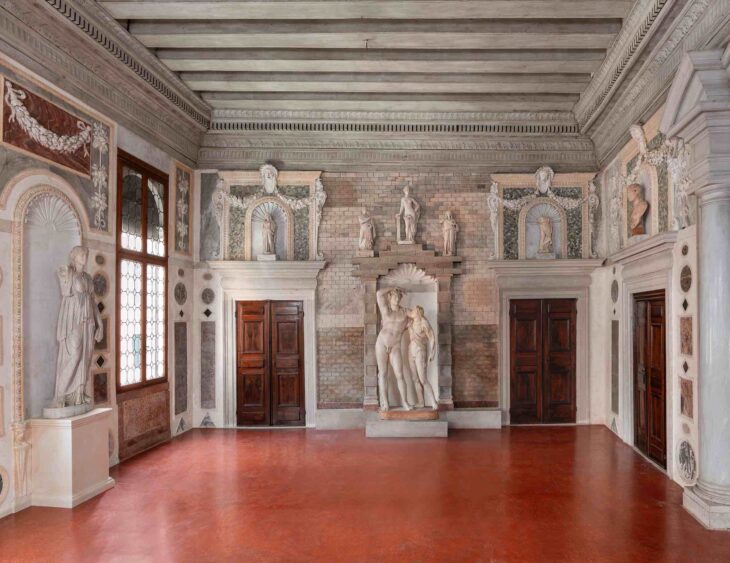
The Room of the Doge in the Palazzo Grimani. Photo: Matteo De Fina
The Sala del Doge, its restoration completed just five months ago, speaks less to the family’s Roman connection than to its deep Venetian roots. The room is airy and open, adjoining the family’s chapel on one side (where a dramatic wooden crucifix from the Chiesa di San Moisè is temporarily on display), and the delicately decorated Camerino di Calisto on the other.
While the Tribuna is more immediately spectacular, the Sala del Doge is, in its own quiet way, just as distinctive. Redecorated according to the 1593 catalogue made by the city officials who came to take an inventory of the collection after Giovanni’s death, the room feels somehow more Venetian: a hodgepodge of ancient and modern materials and styles that mirrors the geographical reach and cultural heterogeneity of the city (and of the family). The windows, niches, and doorways are framed by rhythmic sequences of green, red, yellow, and grey marble mined from quarries in North Africa and the Levant. Most of the 26 statues are elegant pastiches, Roman imitations of Greek models, often restored, and Renaissance imitations of the ancients.
And, of course, the room’s focal point is a shrine to the doge, who was, however briefly, the most powerful man in Venice. At the peak of the broken Palladian pediment that frames the fireplace, a bust of Julius Caesar looks out into the distance. It’s a 16th-century work by Simone Bianco, whose portrait of Antonio in the garb of a Roman emperor, now lost, sat in the same place. Caesar is surrounded by four other busts, two antique – including the famous ‘Grimani Vitellius’ (here a cast) – and two early modern, and we can imagine the doge’s likeness firmly installed in antique greatness. In a daring contrast, directly across from the monument stands a larger-than-life Dionysus flanked by a handsome young satyr, both standing in a sensual contrapposto. Crowning the room’s other Palladian pediment, high over the room’s south door, floats a small red-figure Greek vase – strangely colourful among the white statues, and by far the oldest, and most resolutely pagan, piece in the remarkable Grimani collections. Both here and in the Tribuna, the statuary is arranged largely for symmetry rather than sense, and we never forget that the palazzo is not so much a museum as the home to, and expression of, a particular family.
 The Palazzo Grimani is slowly emerging as a necessary stop on any Venetian itinerary. Restoration only goes so far, however, and in an attempt to recreate the close imbrication of art and architecture that characterised so much of Renaissance art, the curators have commissioned a series of 12 canvases by Georg Baselitz. The paintings, a memento mori cycle hanging in the palace’s enormous Sala del Portego, are enormous and unexpectedly colourful skulls, inverted in the painter’s trademark manner. Their Día de los Muertos air lends a strange exuberance to the space, meditating less on death than on the rebirth that may come after – in keeping with the Palazzo Grimani’s own renaissance.
The Palazzo Grimani is slowly emerging as a necessary stop on any Venetian itinerary. Restoration only goes so far, however, and in an attempt to recreate the close imbrication of art and architecture that characterised so much of Renaissance art, the curators have commissioned a series of 12 canvases by Georg Baselitz. The paintings, a memento mori cycle hanging in the palace’s enormous Sala del Portego, are enormous and unexpectedly colourful skulls, inverted in the painter’s trademark manner. Their Día de los Muertos air lends a strange exuberance to the space, meditating less on death than on the rebirth that may come after – in keeping with the Palazzo Grimani’s own renaissance.
‘La Sala del Doge’ and ‘Archinto’ by Georg Baselitz (both part of ‘DOMUS Grimani’) are at the Museo Palazzo Grimani until 27 November 2022.
Unlimited access from just $16 every 3 months
Subscribe to get unlimited and exclusive access to the top art stories, interviews and exhibition reviews.

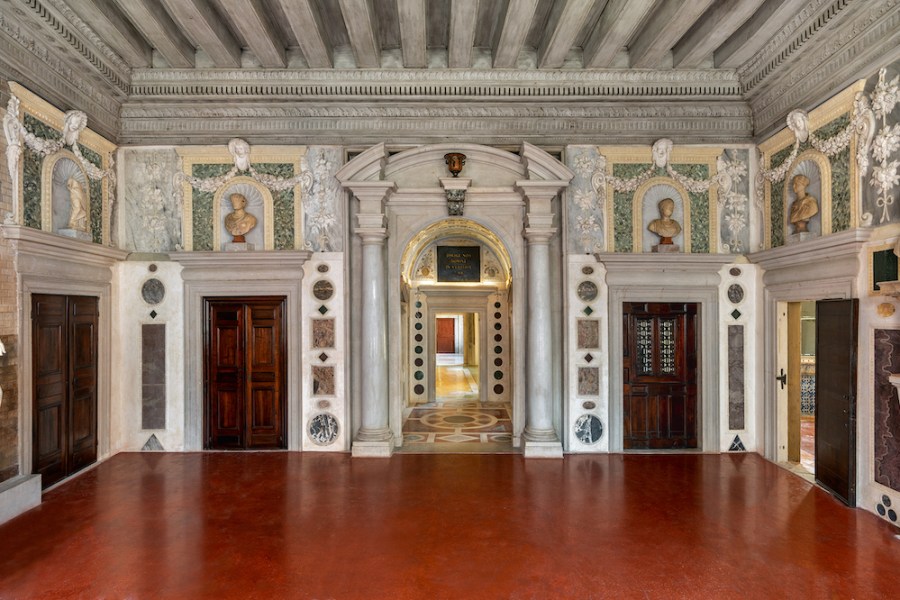
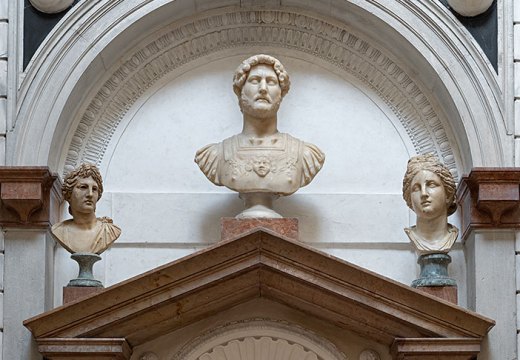
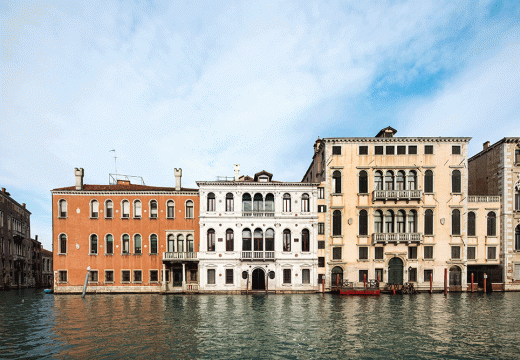
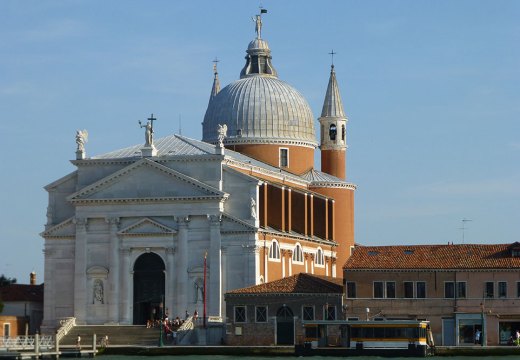









![Masterpiece [Re]discovery 2022. Photo: Ben Fisher Photography, courtesy of Masterpiece London](http://www.apollo-magazine.com/wp-content/uploads/2022/07/MPL2022_4263.jpg)
It’s time for the government of London to return to its rightful home